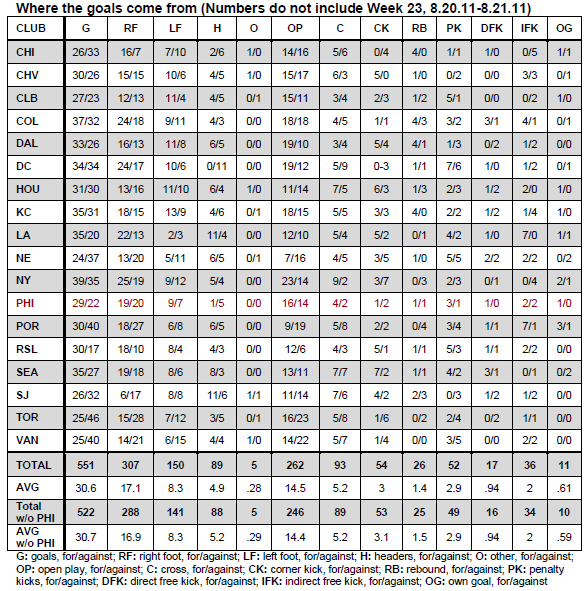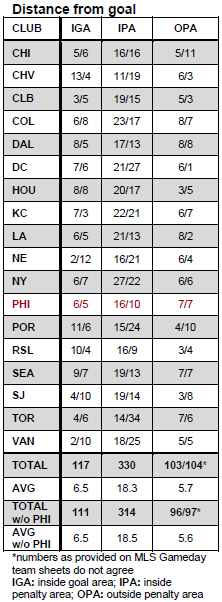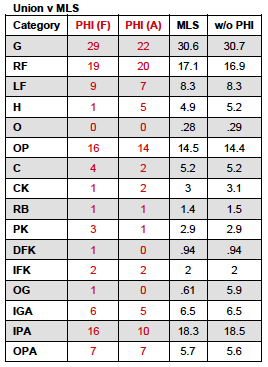Photo: Daniel Gajdamowicz
On Wednesday we posted an article looking at how the Union has scored its goals at home and on the road and how its opponents have scored on them. Today we take a look at how the Union scores its goals and is scored upon compared to the rest of the league.
The numbers
Finding stats on the Union and the rest of the league can take a little bit of searching, but the numbers are out there. To make some sense of them, though, you may have to do a little number crunching of your own.
For the charts below, I went through each Gameday team sheet the league provided for matches occurring the weekend of August 20-21, the most recently available sources of in-depth information that I could find. The numbers therefore do not include statistics from any of last weekend’s games. (I apologize for the small print in the charts but it was the only way I could get them to fit on the page.) Each column in the first two charts contains two numbers, for and against. So, for example, in the Goals column, the Union had scored 29 goals and allowed 22 before the loss to Columbus.
 You will notice that in the rows for totals and averages only one number is displayed in each column. That’s because while each of the for and against numbers are different for each club, when you add up the numbers for all of the clubs the for and against numbers will naturally be the same. (I say naturally, but I added up the for and against numbers for several columns before my thoughts shifted from “talk about your parity” to “duh.”) I’ve included totals and averages without the Union’s numbers just in case anyone was wondering, even the though the averages are not significantly different without them. When comparing the Union’s numbers to the league average in the different categories, I will be using the average that includes the Union’s numbers.
You will notice that in the rows for totals and averages only one number is displayed in each column. That’s because while each of the for and against numbers are different for each club, when you add up the numbers for all of the clubs the for and against numbers will naturally be the same. (I say naturally, but I added up the for and against numbers for several columns before my thoughts shifted from “talk about your parity” to “duh.”) I’ve included totals and averages without the Union’s numbers just in case anyone was wondering, even the though the averages are not significantly different without them. When comparing the Union’s numbers to the league average in the different categories, I will be using the average that includes the Union’s numbers.
 As you can see, the league average for goals scored is almost 31. On average, 17 of those goals come from the right foot, eight from the left foot. Headers account for about five of the goal total with negligible amount coming from some other part of the body.
As you can see, the league average for goals scored is almost 31. On average, 17 of those goals come from the right foot, eight from the left foot. Headers account for about five of the goal total with negligible amount coming from some other part of the body.
On average, just under 15 goals come from open play with another five coming from crosses. Three goals on average have come from corner kicks with about one goal coming from a rebound and nearly three coming from penalty kicks. Direct free kicks account for about one goal and an average of two goals come from indirect free kicks. Own goals are a very minor part of the goal total average.
Distance from goal
In addition to collecting the statistics on how goals have been scored, I also gathered the numbers for where goals have been scored from on the pitch. (The “Distance from goal” chart also includes for and against numbers.)
On average for the league, just under seven goals are scored from inside the goal area, otherwise known as the 6-yard box. Some 18 goals of the league average are scored from inside the penalty area with an average of nearly six goals coming from outside of the 18-yard box.
Union numbers compared to the league
Comparing how the Union scores to the league averages for the various categories, the Union scored more goals from both feet than the league average, more goals from open play, and more goals from outside of the penalty area.
The Union was below the league average for goals scored, goals from headers (and would still be below even with Paunovic’s goal over the weekend), goals from crosses, goals from corner kicks (ditto above), goals from rebounds, goals from inside the goal area and goals from inside the penalty area.
The Union was nearly equal with the league averages for direct free kicks and penalty kicks.
Looking at how goals have been scored on the Union, the Union total for goals allowed is nearly nine goals below the league average. This makes sense given that, up to last weekend’s games, the Union was third on the list of fewest goals allowed. The Union has allowed about three more goals from the right foot than the league average, one fewer goals from the left foot. The Union is just about level in terms of allowing goals from headers, open play, rebounds, and indirect free kicks. The Union allowed fewer goals than the league average for corner kicks, penalty kicks and direct free kicks with the number of goals allowed from crosses three fewer than the league average.
The Union has allowed about three more goals from the right foot than the league average, one fewer goals from the left foot. The Union is just about level in terms of allowing goals from headers, open play, rebounds, and indirect free kicks. The Union allowed fewer goals than the league average for corner kicks, penalty kicks and direct free kicks with the number of goals allowed from crosses three fewer than the league average.
In terms of the distance of goals scored against the Union, nearly two fewer goals have been allowed from within the goal area, with eight fewer goals allowed from within the penalty area. The Union allowed about one more goal from outside the penalty area than the league average.
Another way to look at the numbers
In yesterday’s post about how the Union has scored, I mentioned that the Union has distressingly few goals from corner kicks and set pieces. Simply looking at the league average for corner kick goals shows the Union has ineffectively employed that scoring opportunity.
This becomes even more apparent when you compare the number of Union corner kick goals to those recorded by teams above them in the Eastern Conference table and the top four teams in the Western Conference. Looking at the Eastern Conference, first place Columbus scored one more corner kick goal than the Union, the now in second place Kansas City scored two more corner kick goals than the Union before the games over the weekend while now in third place Houston scored five more corner kick goals. Looking at the top four Western Conference teams, LA scored five more corner kick goals than the Union, Seattle six more, Dallas four more, while Colorado was level with the Union total. If the Union was more effective at scoring corner kicks, how many of the recent string of draws could have been wins?
The disparity is less significant when comparing how many goals the Union’s free kick goals to those of the Eastern and Western Conference leaders. In terms of direct free kicks, both Seattle and Colorado scored two more goals while Columbus actually scored one fewer. The rest of the conference leaders were level with the Union in that category. Looking at indirect free kicks, LA scored five more than the Union, Colorado two more. The other conference leaders were level with the Union’s total with the exception of Kansas City and Dallas, who each scored one less. Generally speaking, goals from free kicks appear to be a precious commodity across the league.


Interesting numbers. Would love to see all of this presented as rates, and some statistical analysis rather than just a presentation of numbers. I think this would show that we’re pretty much average except for goals allowed in the goal area (where we excel) and our inability to score headed goals (was Paunovic’s really the first of the season?).
Goals from free kicks are a precious commodity in any league; see, e.g., this post on goal creation in the English Premier League. http://www.soccerbythenumbers.com/2011/04/shot-creation-in-premier-league-data.html
Neon Keon scored a header earlier in the season.
Not sure what you mean by rates but the second half of the piece is analysis, e.g. is the union above, below or equal to the league averages? Let me know what you mean by rates and I’ll see what I can come up with.
Paunovic’s goal on Saturday was not the first headed goal of the season (Daniel scored against RSL with a header), it was the first header of the season scored from a corner kick (Danny Mwanga scoring the only other corner kick goal with his foot against Toronto. See the post linked to in the beginning of this one for a break down of how the Union scored each of its goals). Keep in mind that when it comes to goals scored the Union are decidedly not average, the Union having allowed nearly nine goals less than the league average (before last weekend’s results), putting them third on the list for fewest goals allowed.
It is not just the Union’s inability to score goals from headers that is a problem, it is that they are not scoring from corner kicks. That’s why I additionally compared the Union’s numbers to those of the conference leaders in an attempt to examine the difference between teams that don’t fall into winless streaks in the middle of the season, those that do, and why that might be.
Thank you for the link. It’s good piece, although it is looking at shot creation, not goal creation.
Didn’t Calif score a headed goal and valdez as well? I think we had more then 1 headed goal for sure.
Both were by foot, Califf’s from a throw in against Houston, Valdes from a free kick against New England. Remember that the numbers in this post do not reflect results from the weekend and thus Paunovic’s header on Saturday against Columbus, which was the second headed goal of the season (and second goal from a corner kick), Daniel having scored the first headed goal.